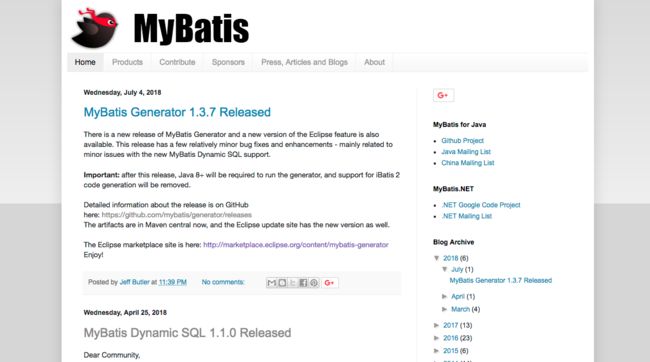MyBatis 是一款优秀的持久层框架,它支持定制化 SQL、存储过程以及高级映射,几乎避免了所有的 JDBC 代码和手动设置参数以及获取结果集,使用简单的 XML 或注解来配置和映射原生信息,将接口和 Java 的 POJOs(Plain Old Java Objects,普通的 Java对象)映射成数据库中的记录,在国内可谓是占据了半壁江山……
ORM框架对比
以下针对Spring JDBC、Spring Data Jpa、Mybatis三款框架做了个粗略的对比。一般应用的性能瓶颈并不是在于ORM,所以这三个框架技术选型应该考虑项目的场景、团队的技能掌握情况、开发周期(开发效率)…
| ORM框架 | Spring JDBC | Spring Data Jpa | Mybatis |
|---|---|---|---|
| 性能 | 性能最好 | 性能较差 | 居中 |
| 代码量 | 多 | 少 | 多 |
| 学习成本 | 低 | 高 | 居中 |
| 推荐指数 | ❤❤❤ |
❤❤❤❤❤ |
❤❤❤❤❤ |
添加依赖
在 pom.xml 中添加 Mybatis提供的用于整合Spring Boot的 starter 依赖包 mybatis-spring-boot-starter
org.springframework.boot
spring-boot-starter-web
org.mybatis.spring.boot
mybatis-spring-boot-starter
1.3.2
org.springframework.boot
spring-boot-devtools
true
mysql
mysql-connector-java
runtime
org.springframework.boot
spring-boot-starter-test
test
数据库及MyBatis相关配置
application.yml
spring:
application:
name: spring-boot-mybatis
datasource:
url: jdbc:mysql://localhost:3306/test_db?useUnicode=true&characterEncoding=UTF-8&zeroDateTimeBehavior=convertToNull&allowMultiQueries=true&useSSL=false
username: root
password: mysql123
driver-class-name: com.mysql.jdbc.Driver
mybatis:
# config-location与configuration不可同时指定
# 否则会报java.lang.IllegalStateException: Property 'configuration' and 'configLocation' can not specified with together
# config-location: classpath:mybatis/mybatis-config.xml # mybatis配置文件位置
mapper-locations: classpath:mybatis/mappers/*.xml # mapper映射文件位置
type-aliases-package: com.example.springbootmybatis.entity # 别名包
configuration:
map-underscore-to-camel-case: true # 驼峰命名eg.表字段user_sex -- 实体属性userSex
# mybatis sql日志
logging:
level:
com:
example:
springbootmybatis:
mapper: debug
MyBatis配置文件
mybatis-config.xml
注意:如果将
mybatis.mapper-locations配置为classpath:com/example/springbootmybatis/mapper/*.xml即mapper接口所在的包路径下,而Spring Boot默认只打入java package -> *.java,所以我们需要给pom.xml文件添加如下内容
src/main/resources
src/main/java
**/*.xml
true
org.springframework.boot
spring-boot-maven-plugin
MyBatis sql日志
对于MyBatis sql日志可以像上面那样在application.yml文件中配置,但在项目中往往使用logback日志框架,因此可以在logback-spring.xml配置文件中添加如下logger
编码实战
表结构
SET NAMES utf8mb4;
SET FOREIGN_KEY_CHECKS = 0;
-- ----------------------------
-- Table structure for tb_user
-- ----------------------------
DROP TABLE IF EXISTS `tb_user`;
CREATE TABLE `tb_user` (
`id` int(11) NOT NULL AUTO_INCREMENT COMMENT '用户id',
`username` varchar(64) NOT NULL COMMENT '用户名',
`password` varchar(64) NOT NULL COMMENT '用户密码',
`create_time` datetime DEFAULT NULL COMMENT '创建时间',
`update_time` datetime DEFAULT NULL COMMENT '更新时间',
PRIMARY KEY (`id`)
) ENGINE=InnoDB AUTO_INCREMENT=17 DEFAULT CHARSET=utf8mb4 COLLATE=utf8mb4_0900_ai_ci;
SET FOREIGN_KEY_CHECKS = 1;
实体类
com.example.springbootmybatis.entity.User
package com.example.springbootmybatis.entity;
import java.util.Date;
public class User {
/** 用户id */
private Integer id;
/** 用户名 */
private String username;
/** 用户密码 */
private String password;
/** 创建时间 */
private Date createTime;
/** 更新时间 */
private Date updateTime;
public User() {
super();
}
public User(String username, String password) {
this.username = username;
this.password = password;
}
// setters and getters ...
}
配置mapper扫描
在启动类中添加
@MapperScan注解开启对mapper包的扫描
package com.example.springbootmybatis;
import org.mybatis.spring.annotation.MapperScan;
import org.springframework.boot.SpringApplication;
import org.springframework.boot.autoconfigure.SpringBootApplication;
@SpringBootApplication
@MapperScan("com.example.springbootmybatis.mapper")
public class SpringBootMybatisApplication {
public static void main(String[] args) {
SpringApplication.run(SpringBootMybatisApplication.class, args);
}
}
不嫌麻烦的话,可以直接在每个Mapper接口上面添加注解
@Mapper
持久层
MyBatis 3提供了基于注解的开发方式,但相比于传统xml映射方式并没有那么灵活,具体可参考官方文档Java API以及SQL语句构建器类两部分
注解开发
com.example.springbootmybatis.mapper.IUserMapper
此示例展示了单表增、删、改、查常见操作
package com.example.springbootmybatis.mapper;
import com.example.springbootmybatis.entity.User;
import org.apache.ibatis.annotations.*;
import org.apache.ibatis.jdbc.SQL;
import org.springframework.stereotype.Repository;
import java.util.List;
@Repository
public interface IUserMapper {
@Insert("INSERT INTO tb_user(username, password, create_time, update_time) VALUES(#{username}, #{password}, now(), now())")
@SelectKey(statement = "SELECT LAST_INSERT_ID()", keyProperty = "id", before = false, resultType = Integer.class)
Integer insert(User user);
@Delete("DELETE FROM tb_user WHERE id = #{id}")
Integer delete(Integer id);
@Update("UPDATE tb_user SET username = #{username}, password = #{password}, update_time = now() WHERE id = #{id}")
Integer update(User user);
@Select("SELECT * FROM tb_user")
@Results(id = "userResult", value = {
@Result(property = "id", column = "id"),
@Result(property = "username", column = "username"),
@Result(property = "password", column = "password"),
@Result(property = "createTime", column = "create_time"),
@Result(property = "updateTime", column = "update_time"),
})
List selectAll();
@Select("SELECT * FROM tb_user LIMIT #{offset}, #{rows}")
List selectList(@Param("offset") Integer offset, @Param("rows") Integer rows);
@Select("SELECT * FROM tb_user WHERE id = #{id}")
@ResultMap("userResult")
User selectById(Integer id);
@Select("SELECT * FROM tb_user WHERE username = #{username}")
@ResultMap("userResult")
User selectByUsername(String username);
@SelectProvider(type = UserSqlBuilder.class, method = "selectLike")
List selectLike(String username);
class UserSqlBuilder {
public static String selectLike(String username) {
return new SQL(){{
SELECT("id", "username", "password", "create_time", "update_time");
FROM("tb_user");
if (username != null) {
WHERE("username LIKE CONCAT(CONCAT('%', #{username}), '%')");
}
ORDER_BY("id");
}}.toString();
}
}
}
注解解释
@Insert、@Delete、@Update、@Select这四个注解分别代表将会被执行的SQL语句。它们用字符串数组(或单个字符串)作为参数。如果传递的是字符串数组,字符串之间先会被填充一个空格再连接成单个完整的字符串。这有效避免了以 Java 代码构建 SQL 语句时的“丢失空格”的问题。然而,你也可以提前手动连接好字符串。属性有:value,填入的值是用来组成单个 SQL 语句的字符串数组。
@Results对应,结果映射的列表,包含了一个特别结果列如何被映射到属性或字段的详情。属性有:value,id。value属性是@Result注解的数组。这个id的属性是结果映射的名称。
@Result在列和属性或字段之间的单独结果映射。
@ResultMap用于引用@Results或的id,无需重复定义
@InsertProvider、@UpdateProvider、@DeleteProvider、@SelectProvider结合SQL语句构建器类使用用于创建动态SQL
xml映射开发
src/main/resources/mybatis/UserMapper.xml
id, username, password, create_time, update_time
com.example.springbootmybatis.mapper.IUserMapper
package com.example.springbootmybatis.mapper;
import com.example.springbootmybatis.entity.User;
import org.apache.ibatis.annotations.*;
import org.apache.ibatis.jdbc.SQL;
import org.springframework.stereotype.Repository;
import java.util.List;
@Repository
public interface IUserMapper {
User selectByPrimaryKey(Integer id);
// 省略以上注解开发代码
}
测试
com.example.springbootmybatis.mapper.IUserMapperTest.java
package com.example.springbootmybatis.mapper;
import com.example.springbootmybatis.entity.User;
import org.junit.Assert;
import org.junit.Test;
import org.junit.runner.RunWith;
import org.slf4j.Logger;
import org.slf4j.LoggerFactory;
import org.springframework.beans.factory.annotation.Autowired;
import org.springframework.boot.test.context.SpringBootTest;
import org.springframework.test.context.junit4.SpringRunner;
import java.util.List;
import static org.junit.Assert.*;
@SpringBootTest
@RunWith(SpringRunner.class)
public class IUserMapperTest {
@Autowired
private IUserMapper userMapper;
private static final Logger logger = LoggerFactory.getLogger(IUserMapperTest.class);
@Test
public void insert() {
User user1 = new User("aaa", "123456");
userMapper.insert(user1);
logger.info("插入记录id: {}", user1.getId());
User user2 = new User("bbb", "123456");
userMapper.insert(user2);
logger.info("插入记录id: {}", user2.getId());
User user3 = new User("ccc", "123456");
userMapper.insert(user3);
logger.info("插入记录id: {}", user3.getId());
User user4 = new User("abc123", "123456");
userMapper.insert(user4);
logger.info("插入记录id: {}", user4.getId());
Assert.assertEquals(4, userMapper.selectAll().size());
}
@Test
public void delete() {
Integer count = userMapper.delete(10);
Assert.assertEquals(Integer.valueOf(1), count);
}
@Test
public void update() {
User updateUser = new User();
updateUser.setId(15);
updateUser.setUsername("jerry");
updateUser.setPassword("jerry123456");
Integer count = userMapper.update(updateUser);
Assert.assertEquals(Integer.valueOf(1), count);
}
@Test
public void selectAll() {
List userList = userMapper.selectAll();
Assert.assertEquals(4, userList.size());
}
@Test
public void selectList() {
Integer pageNum = 2;
Integer pageSize = 2;
List userList = userMapper.selectList((pageNum - 1) * pageSize, pageSize);
Assert.assertEquals(2, userList.size());
}
@Test
public void selectById() {
User user = userMapper.selectById(15);
Assert.assertEquals("jerry", user.getUsername());
}
@Test
public void selectByUsername() {
User user = userMapper.selectByUsername("jerry");
Assert.assertEquals("jerry123456", user.getPassword());
}
@Test
public void selectLike() {
List userList = userMapper.selectLike("a");
Assert.assertEquals(2, userList.size());
}
@Test
public void selectByPrimaryKey() {
User user = userMapper.selectById(15);
Assert.assertEquals("jerry", user.getUsername());
}
}
